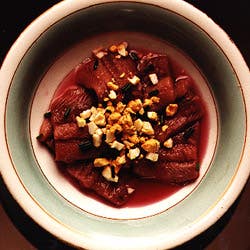
Herring, Herring Everywhere
Swedish menus, like Swedish smorgasbords, eloquently demonstrate the country’s reverence for herring.
Swedish menus, like Swedish smorgasbords, eloquently demonstrate the country's reverence for herring. Americans often find the fish too strong and oily—but sampling it in some of its many Swedish forms can change minds. But where to start? With sillgrataing? Inlagd sill? Matjes? Kraftstromming? Bockling? Surstromming? They're all herring, but their origins—and methods of preparation—vary.
Sill is herring from the cold waters of the North Sea, and is larger and fattier than herring from the Baltic. Sillgrataing, or herring au gratin, is made with these fish, as are most pickled varieties—generically called inlagd sill. This is the herring that turns up, in various forms, on most Swedish menus, with onions and spices, or covered in plain cream, mustard, or tomato sauces. Matjes herring is sill that's been skinned, fileted, and cured in sugar, vinegar, and spices (including sandalwood, which tints it red). It's eaten cold with chopped egg, onion, and chives, or warm with brown butter. (Because it's complicated to prepare, matjes is almost always purchased ready-made.)
Stromming, or Baltic herring, is usually purchased fresh and eaten hot—grilled, fried, or baked. Smoked stromming, called bockling, is a year-round delicacy eaten with buttered crispbread; surstromming, fermented stromming, is a summertime treat—for some. An extremely pungent preparation, eaten with chopped raw onion, potatoes, and strong cheese, it is usually washed down quickly with cold beer or milk. At Christmas, kraftstromming, rolled stromming covered in tomato-dill sauce, is a more accessible treat.
Keep Reading
Continue to Next Story










